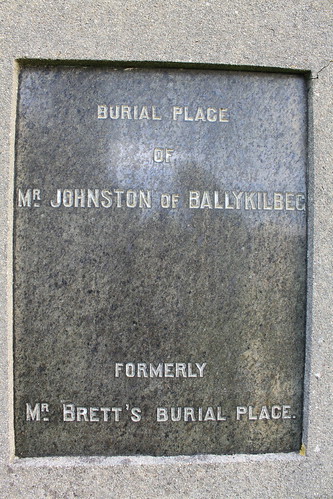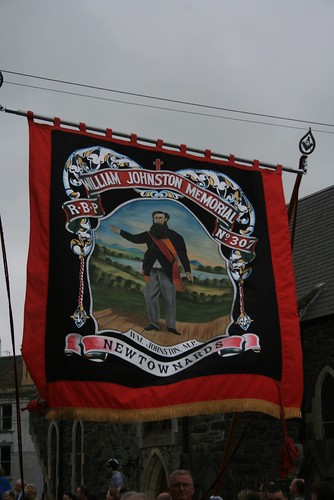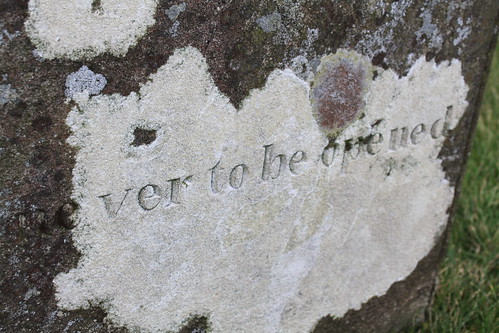Sometimes you'll come across the grave of someone famous, nationally or locally, and you can see how they were respected in their local area and by their own family. You also get an insight into the expression of faith (or lack of) which was held by the deceased through the statements at the bottom of the headstone.
Recently I stopped at the graveyard of Rathmullan Parish Church, near Killough and Tyrella. I had been there several years ago, but hadn't properly explored the graveyard. While it's not big, it contained two graves that led to questions forming in my head.
The first was what should probably be described as a mausoleum. The only proper building with a vault in the graveyard. The inscription was very interesting:

William Johnston of Ballykilbeg is an Orange hero. Back in 1849, Orange parades were very contentious (nothing seems to change in Irish history...). Following the 'Battle' of Dolly's Brae outside Castlewellan, in which several Catholics were killed as the Rathfriland Orangemen returned home from their Twelfth Demonstration Lord Roden's Park (now Tollymore Forest), Orange parades were banned. William Johnston of Ballykilbeg disobeyed the ban by leading a procession on 12th July 1867 from Newtownards to Bangor, for which he was jailed for two months in Downpatrick gaol. Johnston was elected several times as MP for South Belfast, and managed to have the legislation banning Orange parades repealed.

However, the question from the graveyard concerns his burial place. The inscription reports that it was 'Formerly Mr Brett's Burial Place.' So who was Mr Brett? Why was his burial place given to William Johnston? And where was he then buried? A tantalising detail which leads to more questions than it answers.
Later on my wander, I discovered another interesting headstone. This time, the grave of Jane Archer of Downpatrick, who died on 6th September 1836. She is the only person mentioned on the headstone, and down at the bottom is this inscription: 'This grave never to be opened.'

There may be perfectly good reasons for this instruction. Perhaps Jane had some terribly infectious disease which, it was feared, would spread if the grave was reopened. Perhaps Jane didn't like the thought of sharing her resting place with anyone else, or didn't want someone lying on top of her. Perhaps it was an old grave, and her burial was the last to take place in the plot as there wouldn't be any space for further interments. We may never know the reason. But there's one sure thing: her wish will not be granted.
Her grave will one day be opened, on that last day. As Jesus says in John 5: 'for an hour is coming when all who are in the tombs will hear his [the Son of Man's] voice and come out, those who have done good to the resurrection of life, and those who have done evil to the resurrection of judgement.' (John 5:29)
The grave is not our permanent resting place - our ultimate destination is heaven or hell, and every grave, whether Mr Brett's, Mr Johnston's or Jane Archer's will be opened. Even so, come Lord Jesus!
RE the nice words. I know I know, but I struggle with a sentiment to convey how much I appreciate what has been said and I always end up with "Really enjoyed that" or something equally daft. Has to be short enough not to hold up the queue of folk desperate to get the kettle on and long enough to convey that I actually listened. Tough one vicar. MrsMcF
ReplyDeleteoops this was about yesterdays post. Always thought Dolly's Brae was in Coleraine since there was a 'picture' of Dolly's Brae in my grandmother's house and she had a friend called Dolly! Well, well you learn something new every day. Mrs McF
ReplyDeleteYou asked in your blog about the grave of William Johnston---'Who was Mr Brett?'
ReplyDeleteThe Johnstons married into the Bretts of Killough(land owners) in 1760. William J ,originally from Scotland, married Ann Brett.
The famous Orangeman William Johnston's father was John Brett Johnston(1796--1853). The Brett estates passed to an earlier William Johnston( brother of John Brett Johnston) in 1810 and then to John Brett Johnston when that William died in 1843.
I assume that one of ancestors of Ann Brett is the 'Mr Brett'. Marion johnston
Marion, thanks for your comment and the enlightening information! Local knowledge is good, but family knowledge is even better! Now the inscription on the grave makes more sense. Thanks for stopping by.
ReplyDelete